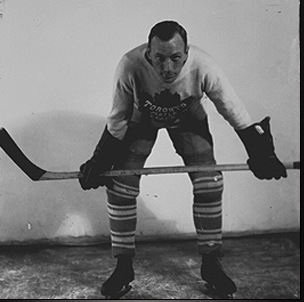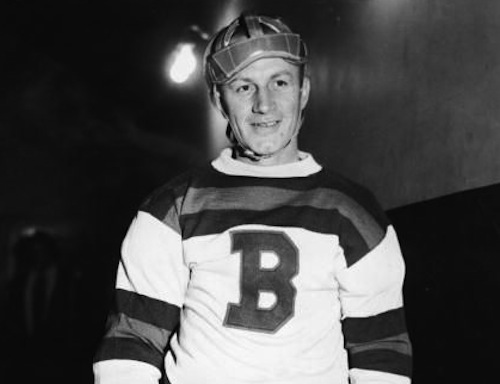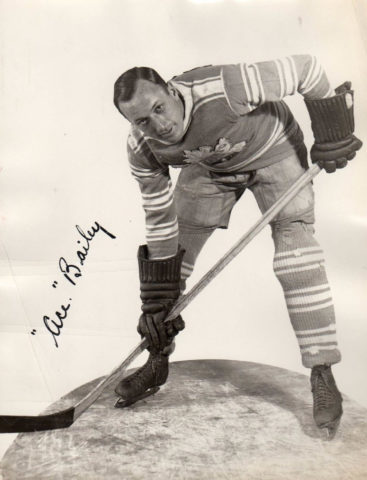The tradition of retiring a jersey number has grown over the years, expanding to every major sports league in North America. It’s a homage to athletes who reach an elite level. Some of the most recognizable numbers in pro sports cannot be worn again by a given team, such as Michael Jordan’s 23, retired by the Chicago Bulls and Miami Heat. Other numbers have been retired league-wide, such as Wayne Gretzky’s 99 and Jackie Robinson’s 42.
This has led to great debates about who should have their number retired next. Retired jersey numbers have also become tidbits of trivia for fans to quiz themselves on. This article should be the ultimate tidbit of jersey retirement knowledge.
The practice dates back to 1934 when the very first pro sports team to retire a number was the Toronto Maple Leafs, and the first number was Irvine Wallace “Ace” Bailey’s No. 6.
Ace Bailey
Bailey was born in Bracebridge, Ontario before leaving to grow up in Toronto. He played junior hockey for St. Mary’s in the Ontario Hockey Association before signing with the Toronto St. Pats (later renamed the Maple Leafs) in 1926.

He was tremendous for the Maple Leafs, scoring 15 goals and 13 assists as a rookie in 1926-27. Two seasons later, he finished first in the NHL in goals and points with 22 and 32. His performance led to a second-place finish in Hart Trophy voting in 1928-29. On teams that included future Hall of Famers Hap Day, King Clancy and Charlie Conacher, Bailey was consistently one of Toronto’s best players.
He led the team in scoring in 1928-29 and 1929-30, and fell just short of the three-peat in 1930-31. The highlight of Bailey’s career was on April 9, 1932 when he scored the Cup-winning goal in Game 3 of the Stanley Cup Final. His goal secured the sweep of the five-game series against the New York Rangers, to win the Cup. It was the only championship of Bailey’s NHL career.
Injury and Retirement
Bailey’s career came to a sudden end on Dec. 12, 1933, when he was hit from behind by Boston Bruins defenceman Eddie Shore. Shore was checked by Clancy of the Maple Leafs and was dazed by the hit. In response, he charged Bailey, thinking he was Clancy. Bailey hit his head on the ice and fractured his skull. His teammate Red Horner knocked out Shore in retaliation. Shore later apologized to Bailey and assured him that the injury was not his intention.

However, the injury ended Bailey’s playing career. The fracture was so severe that some feared he would not survive. He had also suffered cerebral hemorrhaging due to the pressure on his brain and he remained in a coma for ten days (from ‘Maple Leafs: Ace Bailey and the birth of Leafs Nation’ The Star – 12/11/13). He made a full recovery but never played hockey again. He finished his career with 111 goals and 82 assists in 313 games.
An All-Star benefit game was hosted at Maple Leaf Gardens on Feb. 14, 1934, to raise money for Bailey’s family, the first All-Star game held by the NHL 13 years before it became an annual tradition. The game raised $20,909. Bailey and Shore shook hands and embraced at the game to bury the hatchet.
Bailey’s Jersey Retirement
It was during the ceremony at this event that Maple Leafs president Conn Smythe announced that Bailey’s jersey number would be retired, the first time in pro sports. His number 6 was not worn by any Maple Leaf until the 1968-69 season when Ron Ellis wore it at Bailey’s request. Ellis played his final game on Jan. 14, 1981, at which point the No. 6 went back into retirement for good.

Bailey’s was the only retired number for the Maple Leafs until Oct. 17, 1992 when Bill Barilko’s No. 5 joined him and for years, these were the only retired numbers, though others had been honoured. This changed on Oct. 15, 2016, when all of Toronto’s honoured numbers were also retired at a ceremony at Scotiabank Area.
Bailey remained a fixture of the Maple Leafs organization for most of his life. He worked as a timekeeper for the team until 1984 when he was relieved of his duties. He was inducted into the Hockey Hall of Fame in 1975. After battling health problems, Bailey passed away in 1992 at the age of 88. His retired jersey sparked the beginning of a rich sports tradition that continues to be celebrated today.
Enjoy more great hockey history and ‘Best of’ posts in the THW Archives